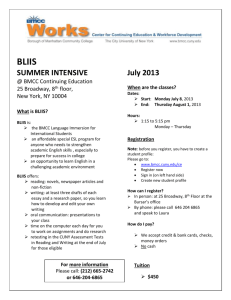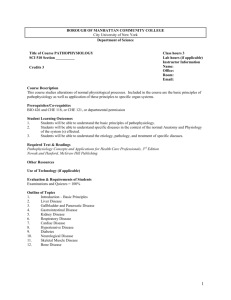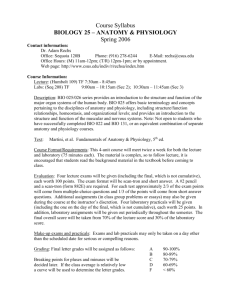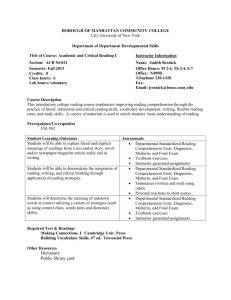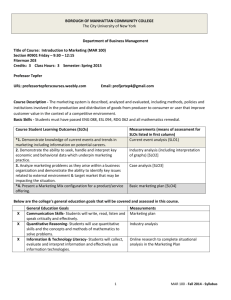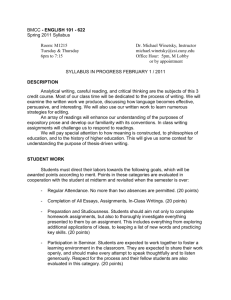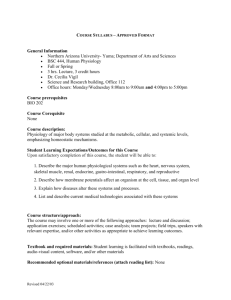BOROUGH OF MANHATTAN COMMUNITY COLLEGE
advertisement
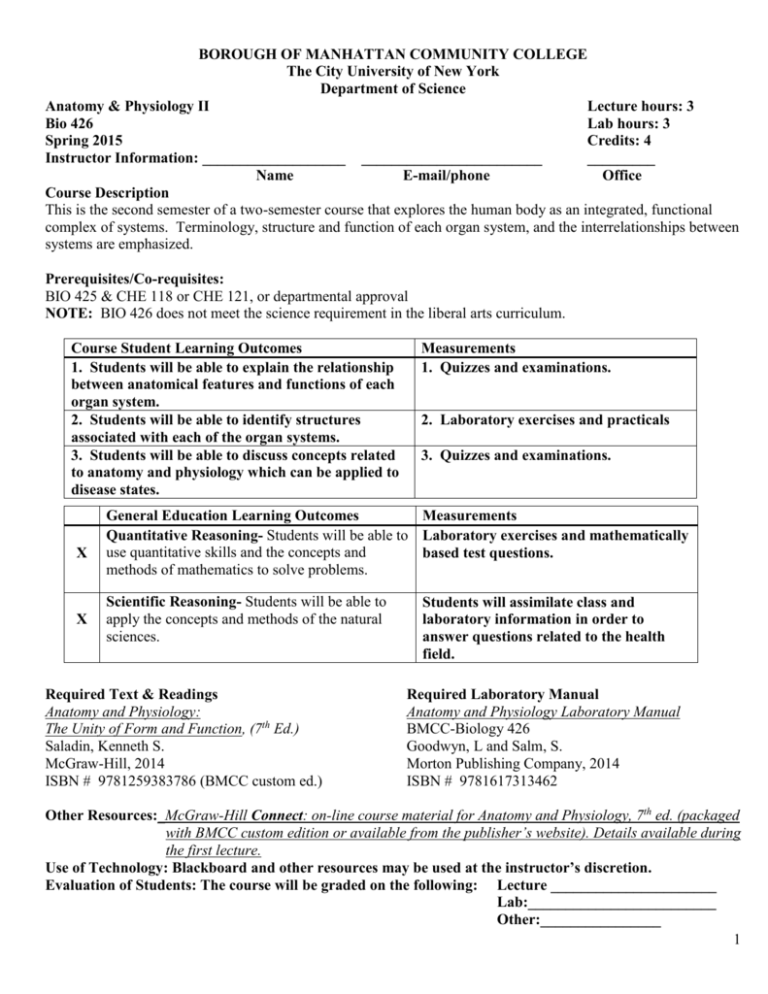
BOROUGH OF MANHATTAN COMMUNITY COLLEGE The City University of New York Department of Science Anatomy & Physiology II Lecture hours: 3 Bio 426 Lab hours: 3 Spring 2015 Credits: 4 Instructor Information: ___________________ ________________________ _________ Name E-mail/phone Office Course Description This is the second semester of a two-semester course that explores the human body as an integrated, functional complex of systems. Terminology, structure and function of each organ system, and the interrelationships between systems are emphasized. Prerequisites/Co-requisites: BIO 425 & CHE 118 or CHE 121, or departmental approval NOTE: BIO 426 does not meet the science requirement in the liberal arts curriculum. Course Student Learning Outcomes 1. Students will be able to explain the relationship between anatomical features and functions of each organ system. 2. Students will be able to identify structures associated with each of the organ systems. 3. Students will be able to discuss concepts related to anatomy and physiology which can be applied to disease states. X X Measurements 1. Quizzes and examinations. 2. Laboratory exercises and practicals 3. Quizzes and examinations. General Education Learning Outcomes Measurements Quantitative Reasoning- Students will be able to Laboratory exercises and mathematically use quantitative skills and the concepts and based test questions. methods of mathematics to solve problems. Scientific Reasoning- Students will be able to apply the concepts and methods of the natural sciences. Required Text & Readings Anatomy and Physiology: The Unity of Form and Function, (7th Ed.) Saladin, Kenneth S. McGraw-Hill, 2014 ISBN # 9781259383786 (BMCC custom ed.) Students will assimilate class and laboratory information in order to answer questions related to the health field. Required Laboratory Manual Anatomy and Physiology Laboratory Manual BMCC-Biology 426 Goodwyn, L and Salm, S. Morton Publishing Company, 2014 ISBN # 9781617313462 Other Resources:_McGraw-Hill Connect: on-line course material for Anatomy and Physiology, 7th ed. (packaged with BMCC custom edition or available from the publisher’s website). Details available during the first lecture. Use of Technology: Blackboard and other resources may be used at the instructor’s discretion. Evaluation of Students: The course will be graded on the following: Lecture ______________________ Lab:_________________________ Other:________________ 1 College Attendance Policy At BMCC, the maximum number of absences is limited to one more hour than the number of hours a class meets in one week. For example, you may be enrolled in a three-hour class. In that class, you would be allowed 4 hours of absence (not 4 days). In the case of excessive absences, the instructor has the option to lower the grade or assign an F or WU grade. Academic Adjustments for Students with Disabilities Students with disabilities who require reasonable accommodations or academic adjustments for this course must contact the Office of Services for Students with Disabilities. BMCC is committed to providing equal access to all programs and curricula to all students. BMCC Policy on Plagiarism and Academic Integrity Statement Plagiarism is the presentation of someone else’s ideas, words or artistic, scientific, or technical work as one’s own creation. Using the idea or work of another is permissible only when the original author is identified. Paraphrasing and summarizing, as well as using direct quotations, require citations to the original source. Plagiarism may be intentional or unintentional. Lack of dishonest intent does not necessarily absolve a student of responsibility for plagiarism. Students who are unsure how and when to provide documentation are advised to consult with their instructors. The library has guides designed to help students appropriately identify a cited work. The full policy can be found on BMCC’s website, www.bmcc.cuny.edu. For further information on integrity and behavior, please consult the college bulletin (also available online). LABORATORY PROCEDURES 1. No food or drinks in the laboratory. 2. All dissection “cuttings and rinsings” must be discarded in appropriate garbage cans. 3. **No such materials may be left in sinks or sink drains! ** 4. All dissecting tools must be washed and returned to their proper trays. 5. Prepared slides must be removed from microscopes, cleaned and returned to their proper trays. 6. Microscopes must have their cords properly wound and tied, and scopes should be on their correct shelves with their numbers facing outwards. 7. Models must be left with all parts attached properly for incoming classes. 8. All tables, sinks, counters and floors should be left spotless. 9. Adhere to all dress code and other instructions outlined in the Laboratory Safety and Protocol document. 2 LECTURE WEEKS TOPICS PAGES 1 Blood 672-707 2 Blood/ Heart 672-707, 708-742 3 Heart 708-742 4 Circulation: Blood Vessels 743-801 5 Circulation: Blood Pressure 743-801 6 Lymphatics/ Immune System 802-847 7 Respiratory System 848-888 8 Respiratory/ Urinary System 848-888, 889-923 9 Urinary System 889-923 10 Water, Electrolyte and Acid-Base Balance 924-946 11 Digestive System 947-993 12 Nutrition and Metabolism 994-1027 13 Reproductive System 1028-1095 14 Development, Growth and Aging 1096-1129 15 Review and Final Examination 3 LABORATORY WEEKS TOPICS PAGES 1 Blood and Blood Cells 1-10 2 Using the Hemocytometer 11-18 3 The Heart 19-26G 4 Blood Vessels 27-37 5 Cardiovascular Physiology 39-45 6 Immune System 47-56 7 Respiratory Anatomy 57-65 8 Respiratory Physiology 67-78 9 Urinary System 79-87 G 10 Digestive System 89-97 11 Fetal Pig Dissection 99-107 G 12 Female Reproduction 109-116 13 Male Reproductive 119-124 14 Fertilization and Early Development 127-135 15 Cumulative Practical** **Practical examinations are at the discretion of the instructor. G Labs for which you will need gloves. 4

